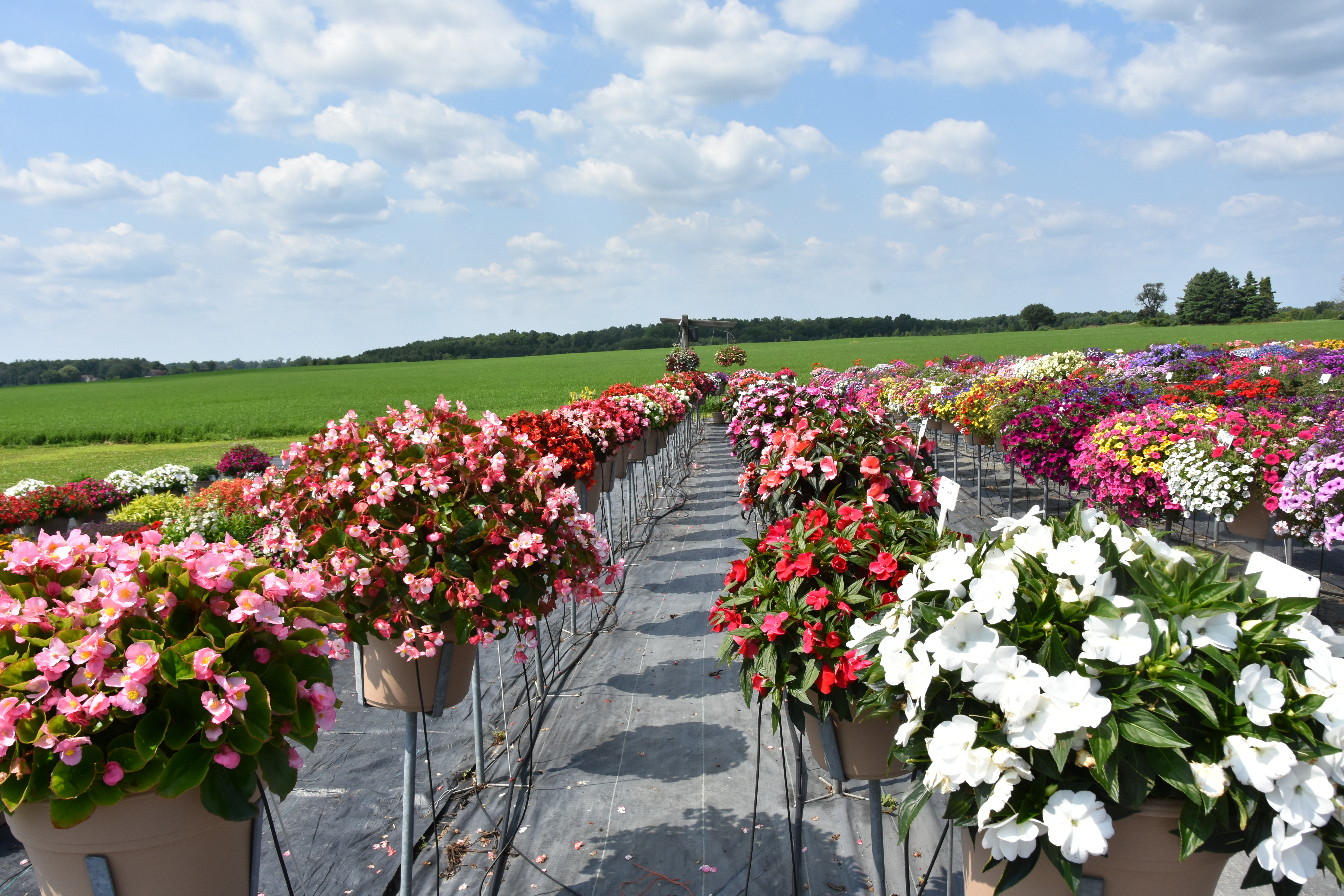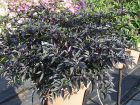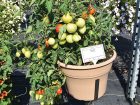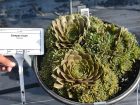
Features
Flowers
New Varieties
New Varieties
A second look at this season’s showstoppers
With close to 3,000 varieties present at the Sawaya Garden Trials, here’s part two of my new and notable highlights.
December 30, 2019 By Melhem Sawaya

In the first article, we discussed 30 new and notable varieties that excelled at the Sawaya Garden Trials this past year.
In this second part, we will explore the remainder of my selections and highlight how they could benefit your operation. The following varieties are listed either alphabetically or grouped with similar varieties, and not listed in any order of importance or by popularity.
Geranium Zonal Dynamo Orange (31) is one in a range of colours for this medium-habit series. Its leaf zoning and high degree of flower power are musts for both sales appeal and for garden performance. Consumers look for colour, and the more of it there is, the faster the product is sold. For good garden performance, fast flowering is needed in geraniums because after every rain, almost all of the open flowers need to be removed to prevent the spread of botrytis. Typically, if no deadheading is done, the entire plant will be dead. Dynamo recovers faster than other geraniums after a rain due to its ability to produce lots of flowers.
Impatiens Beacon White (32) and Impatiens Walleriana Imara Orange Star (33) are two colours from the Beacon and Imara series, long awaited to replace older impatiens genetics. In our trials, the Beacon and the Imara did very well all summer long without any signs of impatiens downy mildew (IDM) and with good garden performance. The double impatiens, such as Impatiens Double Fiesta Coral Orange (34), also did not display any IDM but showed great garden performance with huge double flowers that looked like multiflora roses due to the cooler nights compared to other summers. In comparison, Impatiens walleriana Xtreme (35) was covered with IDM. Hence, even when environmental conditions were favourable for IDM, the Beacon and Imara impatiens were resistant to it.
New Guinea Impatiens Super Sonic Orange Ice (36) and Magnum Fire (37) were not susceptible to (IDM). They performed very well in the trials, which raises the question as to why we need Walleriana impatiens. The New Guinea impatiens perform very well in gardens, with larger flowers and resilient growing habits. They also take the sun better than the shade. In our trials, all were grown in full sun without negative effects, showing better growth habits and more flowers compared to growing in the shade.
If you like the habit of New Guinea impatiens but want more vigour and double flowers, you now have more choice. New Guinea Impatiens Roller Coaster Hot Pink (38) has the New Guinea habit but with higher end flowers that could be suitable for selling in an upgraded container for better margins. If you are after vigour and good garden performance, try new crosses like New Guinea Imp. Sunstanding Jazzy Coral (39) and the outstanding Impatiens Sunpatiens Compact Tropical Rose (40). The latter is one colour of the versatile Sunpatiens series that can transform a mediocre garden to one positively exploding with healthy plants seen from 100 ft. away.
Lantana Hot Blooded Red (41) is a breakthrough in breeding. The plant is sterile. It does not produce any seed, which gives the plant more energy to continuously produce more flowers. Lantana is the best hot-weather genera, and it is vastly underused. In our trials, Hot Blooded Red had excellent garden performance throughout the whole summer, without the need for deadheading. In addition to thriving in extreme heat, rainy days did not affect the hot blooded red lantana as it bounces back immediately. Great alone, in combinations, and in mixed containers.
Lotus Berthelotii Red (42). The lotus flower on the Berthelotii are exceptional, but unfortunately hard to produce. It needs to be aged, then cooled for 6 to 10 weeks before being forced under bright light conditions. I would suggest using this lotus vine as an accent in combinations as it can complement any mix without taking over.
Nepeta Blue Prelude (43) is a first-season flowering perennial that has scented foliage, and attracts bees and butterflies. This excellent garden performer blooms through the whole summer and well into frost. Blue Prelude can be grown in gallons for landscape or in large containers mixed with other perennials or annuals.
Ornamental Pepper Midnight Fire (44) is a black foliage plant with loads of peppers that is great in pots, landscape and mixes. In addition to its excellent look and performance, Midnight Fire, like other ornamental peppers, is an excellent host for Orius, a beneficial predator that will feast on many pests.
Osteospermum Sunny Hazel Orange (45) is a garden performer that blooms the whole summer long, holding strong through hot weather and excelling during cooler nights. The flowers on this variety last a long time as well. It is very floriferous, offering four flower flushes before any deadheading is needed. By looking at the plant, you will notice that there are four stages of flowers that are still in good shape, which is a great sign of its longevity in flower cycling and the floriferous power of the plant. Sunny Hazel Orange is great for large containers, landscapes and mixed containers.
Petunia Easy Wave Blue (46) is a medium vigour plant and flowers at an early stage, so it can be shipped in colour and in small containers. However, its medium-sized flowers recover slowly from the rain. In comparison, Petunia Shock Wave Denim (47) is more vigorous, with many more flowers that stand up to the rain and with no deadheading needed, but it flowers more vigorously without growth regulators. Petunia Tidal Wave Silver (48) is one of a much more vigorous series than both the Easy Wave and Shock Wave. Two plants of Tidal wave will generate a petunia tower in less than 8 weeks. If you are looking for a large landscape with large pots or in the ground, Tidal Wave is your answer. All three Wave series are from seed, which helps avoid the diseases and pests that could accompany vegetative cuttings.
Having said that, there are some vegetative petunias which perform very well too, and each have their own advantageous characteristic(s). Petunia ColorRush Pink (49) is one of my favourites this past season – self-cleansing, semi-vigorous and tolerant to rain. Petunia Dekko Deep Lavender Vein (50) is another excellent garden performer with a trailing habit that has smaller, but many flowers throughout the whole season without looking tired for a moment. Dekko Deep Lavender Vein is great in big containers, hanging baskets and best in mixes where it gels with other cultivars to give a great show.
Petunia Tea Purple Vein Purple (51) is one colour from the Tea series which is new to our trials. I was impressed with its garden performance throughout the whole summer and its fast recovery from rain, a shining selection among the series. By next season, I will know if these initial observations hold true in greenhouse production when put through different conditions and different growers.
Petunia hybrida Capella Baby Pink (52) is a compact variety that did very well in our garden trials. Normally, compact varieties run out of energy under high light and temperature conditions, but not the Capella series, which offers a mounding habit with self-cleansing characteristics.
Petchoa SuperCal Premium Caramel Yellow (53) is one colour in the toughest series of petunias we tested. It stands up better to cooler temperatures than other petunia series and thrives in hot weather conditions. The Petchoa Supercal has a mounding vigorous habit, but flowers easily. So for greenhouse production, planting later is recommended. Growers planting earlier should force at cool temperatures for a better finished product. Petchoas are great in hanging baskets and mixed hanging baskets.
Rudbeckia Denver Daisy Yellow (54) was one of the better garden performers in landscape and in our trials. Some other varieties flower earlier and look cuter at sales time, but most of them do not do very well in landscapes. Denver Daisy Yellow is a strong plant where its flowers not only last long, but flower within the first season.
Salvia Mystic Spires (55) was the most photographed variety in among the entire trial, and for good reason. This variety offers five generations of flowers, which means the flowers can last for a long period of time. The butterflies and humming birds can’t seem to stay away from it. This variety is a great choice for the center of planters and even better in landscape. For greenhouse production, Salvia Mystic Spires should be grown in 6” pots or gallons so we do not have to over treat it with growth regulators. The other option is to grow it in 4” containers and not give it a long growing period, then sell it green. The roots will become established more quickly in the gardens, and you will save on watering frequency due to deeper established roots. For retail, you can grow large containers started earlier to show what the final product in the garden will look like, or have pictures from the year before on a monitor with instructions.
Senecio Angel Wings (56) is a different plant that has a very soft velvety feel. Anybody that passed by Senecio Angel Wings had to touch it with their hands, and many had to rub their faces in it. This variety is not for small containers because it does not show its potential until it has filled in and the leaves project their magnetic look and feel.
Setcreasea Purple Queen (57) is a well-produced cutting of an old genus that was not used much because of limited or inferior supply. Now with better supply, this variety is a must in many mixes where it adds very different characteristics compared to other fillers. Experiment with it in different mixes and you will be surprisingly pleased.
Here is an idea for you. Mix Senecio Angel Wings with Setcreasea Purple Queen (58) for completely different textures and colours. When put together, they stand proud independently but still complement each other.
Strobilanthes Persian Shield (59) with its purple shades makes one of the best items for the center of a mixed container. Be sure to grow Strobilanthes under long days or else it will flower (which is not desirable) and almost go into dormancy. The solution is to get it early and keep it under long days, or get it in April from propagators who you know use long days.
Tomato Garden Gem (60) is for container production. We now have many tomato varieties that will do fine in containers, but make sure that only one plant is placed in at least a 14” container or larger, such that watering is easier to manage. Economically speaking for both the grower and the consumer, plants could be grown in 1 gallon containers, and the consumer can then plant it in larger pots. Other than for economic reasons, it is better for the plant to be placed deep inside a larger container such that new roots can be easily established and lead to a stronger plant.
With these next three combinations, there is something we can learn from each of them to enhance our mixed containers and make them different. MixMasters Shoot the Breeze (61) is a uniform mix where all the cultivars not only enhance each other, they are visible all summer long and not just at sale time. Peach of My Heart (62) is a mixed container where the Sunpatiens component makes almost any mix more colourful while offering excellent garden performance at the same time, which is important for the longevity of a good combination. Mix Woodland Perennial 2 (63) is a different mix that is extremely drought-tolerant. In our trials, this was the mix that was most photographed and inquired about.
BONUS ONLINE MATERIAL:
The following were additional varieties that stood out at the Sawaya Garden Trials this year:
Vinca Valiant Apricot (64) is a colour in the valiant series that is great in landscape. Yes, vinca is great in landscape in Ontario and in most of Canada. Some days, we are warmer than Florida! The new varieties are disease-resistant, and the plants flower the whole summer long. I like Valiant because they branch and then keep growing, which is essential for the plants to root faster.
Viola Admire Orange Purple Wing Imp (65) is not only for cool weather. In our trials for the last three years, the Admire series flowered the whole summer long, so it is ok to use the Admire viola series and some other newly bred violas for summer sales as well as in combinations, which I have seen and they look great throughout the whole summer.
Sempervivum Kalinda (66) is a succulent that is obviously extremely drought-tolerant. What I liked about this variety was when we got the plants in June, there were three plants in a large 14” pot, yet here it is pictured after 7 weeks with minimal watering.
As always, try some of the new varieties first and if they are successful, increase their production in the next year but make sure to drop some of the less successful ones.
Melhem Sawaya of Focus Greenhouse Management is a consultant and research coordinator to the horticultural industry, mel@focusgreenhousemanagement.com.
Print this page



































